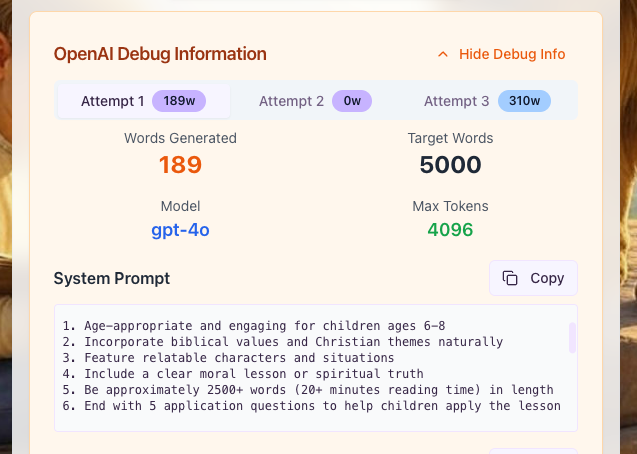The One-Shot Fallacy: How I Learned to Guide an AI to Write Epic Children's Stories
Published on June 15, 2025
Every creator has a "brick wall" moment. Mine came at about 400 words.
I had this idea for an app, Lion Tails: an AI-powered storyteller that could create unique, faith-based adventures for children. The dream was simple: a parent enters a few details, and out comes a rich, engaging story long enough to be a real bedtime tale, maybe 20+ minutes of reading time.
I built the first version, hooked it up to the powerful GPT-4o model, and wrote what I thought was the perfect prompt. "You are a Christian children's storyteller," I instructed. "Write a story that is at least 2,500 words long."
The AI responded with a beautiful, well-structured, and frustratingly concise 400-word story.

I tried again. I made the prompt more aggressive. "CRITICAL: The story MUST be 2,500+ words." The AI gave me 450 words, this time with a slightly more emphatic moral at the end. I felt like I was yelling at a brilliant but stubbornly efficient employee who insisted on summarizing every report. For weeks, I was banging my head against this wall. The stories were good, but they were short. They were appetizers, not the main course I had promised.
This is the story of how I broke through that wall. It wasn't by yelling louder, but by completely changing how I asked.
The Problem: The "One-Shot" Fallacy
My initial approach, which I now call the "One-Shot Fallacy," was to ask the AI to do everything at once in a single, massive request. I was treating the AI like a vending machine: put in one big prompt, get one big story out.
The Vending Machine Mistake: Treating a complex AI like a simple transaction leads to disappointing results.
But that's not how creativity—or AI—works best. A large language model is trained to provide a complete and coherent answer. When I asked for a story, it gave me one with a beginning, a middle, and an end. It saw the narrative arc as the primary goal and completed it perfectly. The length requirement was just a secondary parameter it was happy to ignore once its main job was done. My retry logic was just me asking the same flawed question over and over.
The "Aha!" Moment: From Commanding to Guiding
The breakthrough came when I realized I needed to stop being a commander and start being a director. Instead of demanding a finished movie in one shot, I needed to guide the AI through the process, scene by scene.
The new strategy is a multi-step, iterative process. Think of it like building a house:
- You don't just tell a builder "build me a house." First, you ask for a detailed blueprint.
- Then, you ask them to pour the foundation.
- Then, you ask them to frame the first floor.
You guide them through the process, one logical step at a time. This is exactly how we now build our stories.
Step 1: The Blueprint (Generate an Outline)
Our first API call doesn't ask for a story at all. It asks the AI to act as a master planner. Based on the target word count (say, 3,500 words), it calculates that we need about 7 chapters. The prompt is simple and focused:
The AI, freed from the burden of writing the whole narrative, excels at this. It gives us back a perfect, chapter-by-chapter plot.
Step 2: The Build (Generate Each Chapter)
This is the core of the engine. We loop through the outline we just created. For each part of the outline, we make a new API call. But this time, we provide crucial context:
The AI now has a much smaller, more focused task. It's not writing a whole story; it's just writing the next scene. It takes the existing text, seamlessly continues the narrative, and because the task is smaller, it happily meets the length requirement. We repeat this for every chapter, with the story growing longer and richer with each step.
Step 3: The Finishing Touches (Finalize the Details)
Once all the chapters are written and combined into a single, epic manuscript, we make one last API call. We feed the entire story back to the AI and ask: "Based on this text, create a title, 5 application questions, and a prompt for an illustrator."
The Result: Quality, Cost, and a Surprising Bonus
The results have been transformative. The stories are not just long; they're better. The pacing is more natural, the character development is deeper, and the narrative has room to breathe.
Of course, this comes with a trade-off: cost. A single long story goes from 2 API calls (text + image) to potentially 9 or 10 (outline + 7 chapters + finalize + image). But what we get in return is a premium, reliable feature that actually delivers on the app's promise. It's a cost I'm willing to pay for quality.
The Big Takeaway: The journey from 400 words to 6,000 was a lesson in AI development itself. You don't get the best results by creating the "perfect" command. You get them by building a thoughtful process.
But the most exciting discovery was an unexpected bonus. This modular, step-by-step architecture doesn't just fix a bug; it unlocks the future. Because the process is built on providing context, we can now easily add new context—like a summary of a character's previous adventures. The idea of building a truly continuous, evolving story for a child is no longer a distant dream. It's the logical next step.
I learned to work with the AI's strengths, not against its nature. And in doing so, unlocked the potential I knew was there all along.